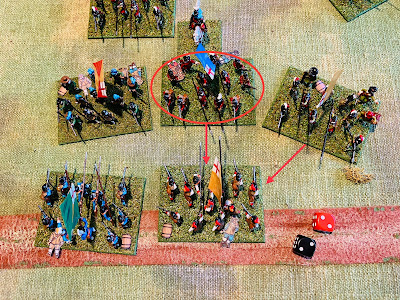I have finally got around to writing up all my notes and scribbles to the English Civil War rules for larger battles. The rules have been added to the tabs at the top of the blog, or you can click here.
 |
| Deployed ready for a game. |
I thought I would have a go at writing down some design notes and try and explain why some of the rules came about. First up though, the rules have drawn inspiration from a number of books, rulesets, and games, the main ones include:
"One-Hour Wargame Pike and Shot rules" by Neil Thomas
"With Pike and Musket" by C.F. Wesencraft.
“Pike and Shot Tactics 1590-1660” by Keith Roberts
“Edgehill - The Battle Reinterpreted” by Scott, Turton, Gruber von Arni
“Thirty Years War - Quad Game” by SPI.
One paragraph from Wesencraft’s book captured what I wanted from my English Civil War games very concisely.
“The English Civil War battles typically saw infantry formations positioned in the centre, facing the enemy's infantry, while cavalry units occupied the two wings. The artillery guns were positioned in front of the infantry. Consequently, four distinct actions took place during the battle. First, the guns bombarded each other, followed by clashes between the opposing cavalry wings. Finally, the infantry engagement occurred. Interestingly, each action often occurred independently, without mutual support. Even victorious troops tended to prioritise chasing down their particular foes instead of assisting other sections.”
Here are some of the period details I wanted to try and highlight or reflect in the rules…
Lack of flexibility and reliance on formations
Armies of this period lacked flexibility, relying heavily on formations, and were constrained by their level of training. This meant cavalry and infantry rarely integrated, and once a battle commenced, command and control posed significant challenges. For commanders, the deployment of their forces was crucial and often decided beforehand in war councils with their advisors, taking into account the training level of their troops. To try and reflect this there is no one rule mechanism, but instead a collection of rule mechanics are used:
- The army’s units are organised into commands: right flank, left flank, centre, reserve, artillery, or dragoons.
- Units must be deployed within their respective commands, with no mixing of infantry and cavalry in a single command.
- The number of units that can move is restricted by the use of orders. Where each player can issue two orders per game turn. Orders issued to a command allow all units in that command to move, or in the case of artillery undertake a bombardment. So a player is limited to ordering two commands, or one command and artillery bombardment.
- Units moving outside their 45-degree forward arc or making turns are limited to 3 inches of movement. Making it had to react to enemy actions not directly ahead of a unit.
- Units that maintain formation with other units supporting receive a bonus by increasing the number of hits they can withstand before they rout. However, this also means units may suddenly rout if the supporting units on the flank of their formation are lost.
Artillery to be useful but limited
Artillery was useful but not decisive, and was hauled around by the armies of the period. The separate artillery bombardment phase forces players to give up an order use their guns. This way they are often used at the start of a battle, then less often as the battle progresses and players want to use their limited orders to react to enemy movements.
Cavalry Charging Off
Cavalry of the period quite often pursued their opponents from the field of battle. They did this to: stop them from taking further part in the battle, capture the enemy baggage, or undermine the enemy army’s morale. I wanted the rules to reflect this behaviour. So, when cavalry reach the supply markers positioned at the rear, along the army's base table edge, they earn victory points.
Offer retirement, falling back, as a sensible option
Simultaneously combat encourages units to fallback against unfavourable odds so they can reduce the amount of combat their units are involved in. Players can decide to give up ground and position to preserve their units, while waiting for reserves or focusing their attacks in other areas.
Involvement of Commanders
Commanders of this period were often engaged in combat rallying and encouraging their troops. This comes with a risk of them being killed or having to leave the field of battle wounded. Players can choose to use their commanders to gain an advantage in combat, but this comes with the risk of losing victory points.
Routs of units based upon their tactical situation
The number of hits units can withstand before routing depends on their support for infantry and cavalry, as well as their tactical position. This approach removes the need to account for cover or other terrain benefits in the combat rules, and units committed to defensive positions will often have to remain in those positions after taking hits which should they move from cover cause them to rout.
Ammunition Supplies
Ammunition could become an issue in prolonged engagements, especially if supply were inadequate. This simple approach is borrowed from One Hour Wargames rules.
Victory Conditions
The use of victory points was introduced to reward players to have their cavalry pursue routed opponents off the field. It was later expanded to include losing points for the loss of commanders, which could lead a commander-general to think they were losing the battle. This system also has the traditional points awarded for routing half or more of the enemy, enemy losses, and capturing objectives.
The next post will have a game report using the rules.





















































